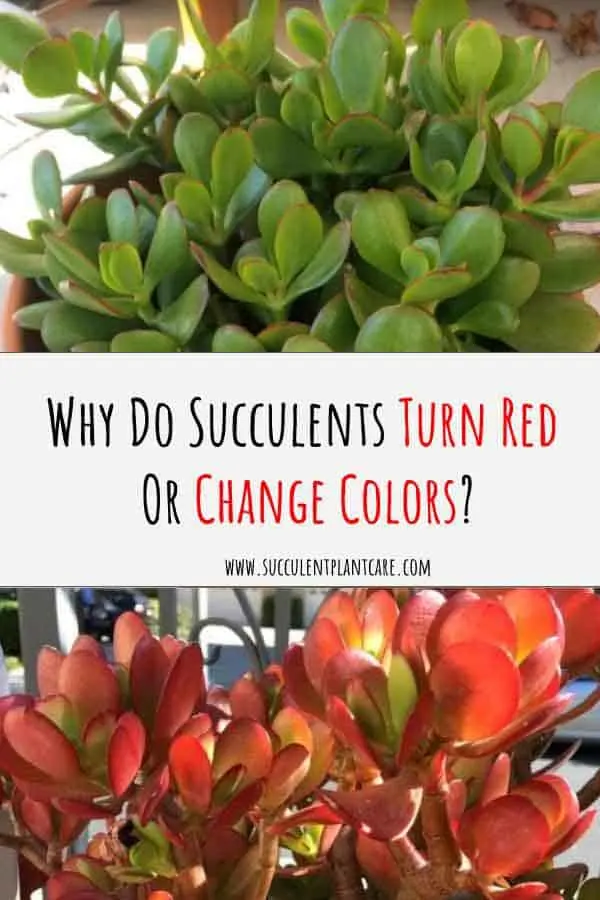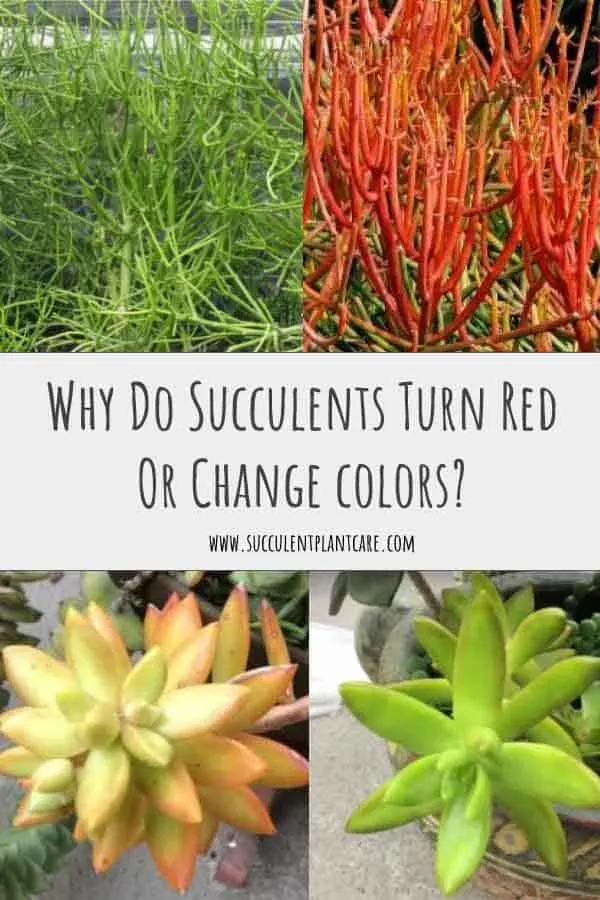Like you, I have also wondered why my succulents are turning red or changing colors. After I learned more about why succulents change colors, I began to appreciate these color changes more and actually enjoy seeing them in my plants.
While these changes are usually harmless, here are a few things you should know about color changes in succulents.

So Why Do Succulents Turn Red Or Change Colors In The First Place?
Succulents turn red in response to the extreme conditions in their environment. Pay attention to your plant and you will notice that it starts to turn red or change its color when faced with one or more of these conditions, but be sure to read through the article because some of these stress are not good for your succulent:
Reason 1: When the plant is exposed to a lot of sun, especially full sun.
Reason 2: When the weather turns really hot or really cold. You will notice your plant turning red or changing colors during the hot summer months and cold winter months.
Reason 3: When the plant is watered sparingly. When the plant is not receiving regular watering it starts to appear less green and you will notice it turning a different shade.
Reason 4: When the plant is not well fed. When you do not feed or fertilize your plant regularly, you will notice the color changes in your plant.
Reason 5: When the plant is in poor soil. Along with not fertilizing regularly, when your plant is sitting in infertile soil or soil that is not rich in nutrients, you will see these color changes more.
When a succulent experiences one or more of these conditions mentioned above, the plant is actually under ‘stress’. The plant is reacting to the extremes in the environment by exhibiting these color changes.
What Is Stress and Does It Harm the Plant?
When you think about where succulents come from and how they grow in their natural habitat, it makes sense that succulents seem to grow even more beautiful under stress. Most succulents come from dry, arid areas and desert conditions. Some succulents are found in mountainous regions, rain forests, and even sea coasts.
Succulents naturally grow in regions that are considered uninhabitable by other plants. Their natural habitats are usually too harsh for other plants to survive. For these reasons, succulents are highly adaptable to survive and thrive in extreme environmental conditions. Therefore when succulents are under stress in cultivation, it is like mimicking their natural environment.
The plants are not being harmed by it but are in fact designed to live under these conditions. They are highly equipped to survive and thrive in these environments. (To read more about where succulents come from and their native habitats, click on my post “What Is A Succulent Plant? Is It The Same As A Cactus?”)
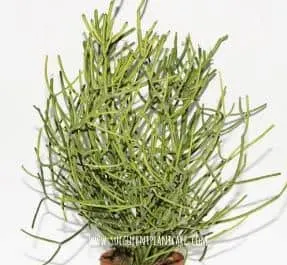
Euphorbia tirucalli ‘Fire Sticks, Stick On Fire, Red Pencil Tree’ under different growing conditions. One has stayed mostly green while the other has red tipped leaves.
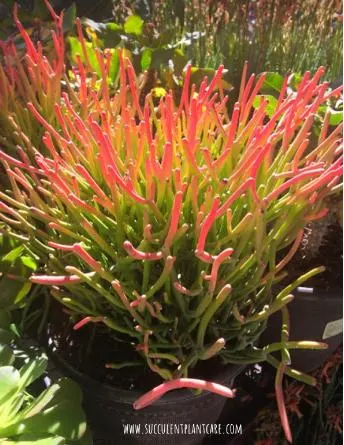
Why Do Succulents Change Colors Under Stress?
Aside from red, succulents can also turn different shades of yellow, orange, purple, blue and black. This is due to the natural pigmentation present in plants that are also found in fruits. Without being too technical, these pigments are called anthocyanins and carotenoids and they are responsible for color changes that take place in plants. These pigments are also found in fruits that are high in antioxidants.
This tells us that these pigments present in fruits that are responsible for providing us with precious antioxidants in our diets are also present in plants to protect them from their environment. This serves as the the plant’s built-in mechanism to protect it from extreme climate changes such as extreme heat and drought.
While stress can bring out amazing colors and beauty in succulents, there are other types of stress to watch out for that signal that the plant is in trouble.
How To Tell If Your Plant Is In Trouble: Good Stress vs. Bad Stress
Is there such a thing as good stress and bad stress in succulents? Yes. Generally speaking, a stressed plant that is healthy will maintain its original shape and features while changing its color. A stressed plant in trouble will appear distorted, disfigured or just unwell.
Getting to know the type of plant you have will help you determine whether the plant is in trouble or not. Some succulent plants naturally get reddish tips on their leaves when exposed to full sun or extreme heat. The plant is coping with the extreme heat by producing a red pigment (carotenoids) on its foliage to protect itself from sunburn. We can call this ‘good stress’ because the plant is not being damaged by it but actually brings out the beauty and color of the plant.
On the other hand, reddish tints on succulents’ leaves and stems could be a sign of an insect infestation such as spider mites, which leave red marks on the plant. The leaves would also appear misshapen, which signals something is wrong with the plant. We can call this ‘bad stress’ because the plant is actually being harmed and you need to take immediate action to save the plant.
When you see red hues on your plant, examine it to see whether or not it is a natural process or something else is bugging the plant.
Some plants turn a nice shade of yellow-orange when exposed to full sun, extreme heat and very dry conditions. This is the plant’s way of coping with the extreme environmental conditions to protect itself. This is ‘good stress’ because the plant is not suffering and you do not need to take immediate action.
On the other hand, a plant can turn yellow from overwatering or constantly wet soil. Along with yellowing of the leaves you will also notice that the leaves are soft and mushy. This is ‘bad stress’ and you need to fix the situation before it becomes worse.
Unlike ‘bad stress’, with ‘good stress’ there are no accompanying signs or symptoms like mushy leaves to signal that the plant is in trouble.
Some plants such as the Echeveria ‘black prince’ and Aeonium arboreum ‘Zwartkop’ (Black Rose) turn a beautiful shade of dark purple to black under ‘good stress’. Pamper these same plants, keep them in the shade with regular watering and they will lose these beautiful pigmentation and will turn to green.
However, if you see some your succulents turning black from the bottom up with leaves falling off, this is definitely considered ‘bad stress’. This is when the plant is rotting from the root up. The leaves turn black and the stems rot. You need to take action immediately or you can lose the plant.
It doesn’t take much to get to know your plants so you can figure out whether they are under good or bad stress. After a while, you would be able to tell the difference.
Sedum Rubrotinctum ‘Jelly Beans, Pork and Beans’
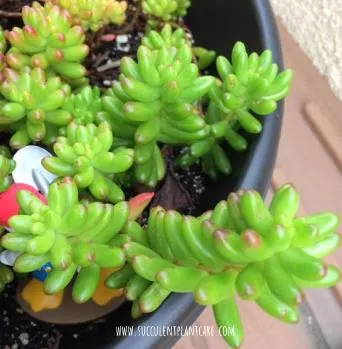
The one with green leaves is in partial shade and receives plenty of rainwater.
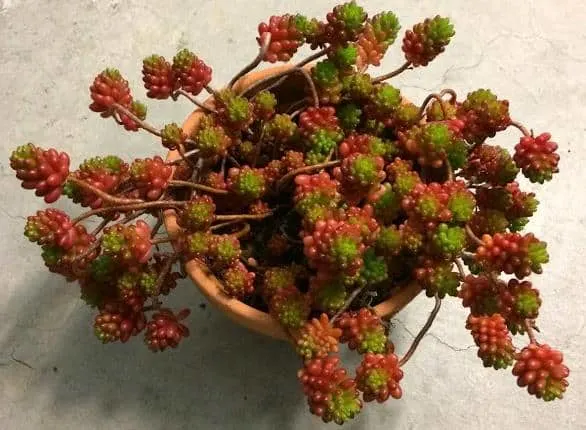
The one with reddish tips is in full sun with minimal water.
Crassula Ovata ‘Jade Plant’ in three different colors
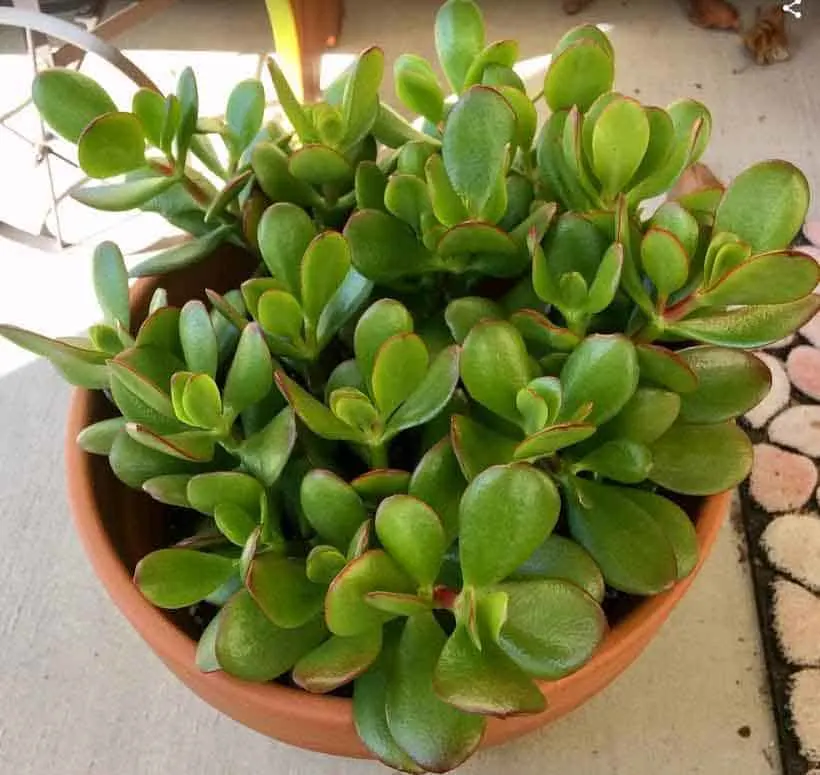
One with green leaves is kept in the shade and newly potted in fresh potting mix.
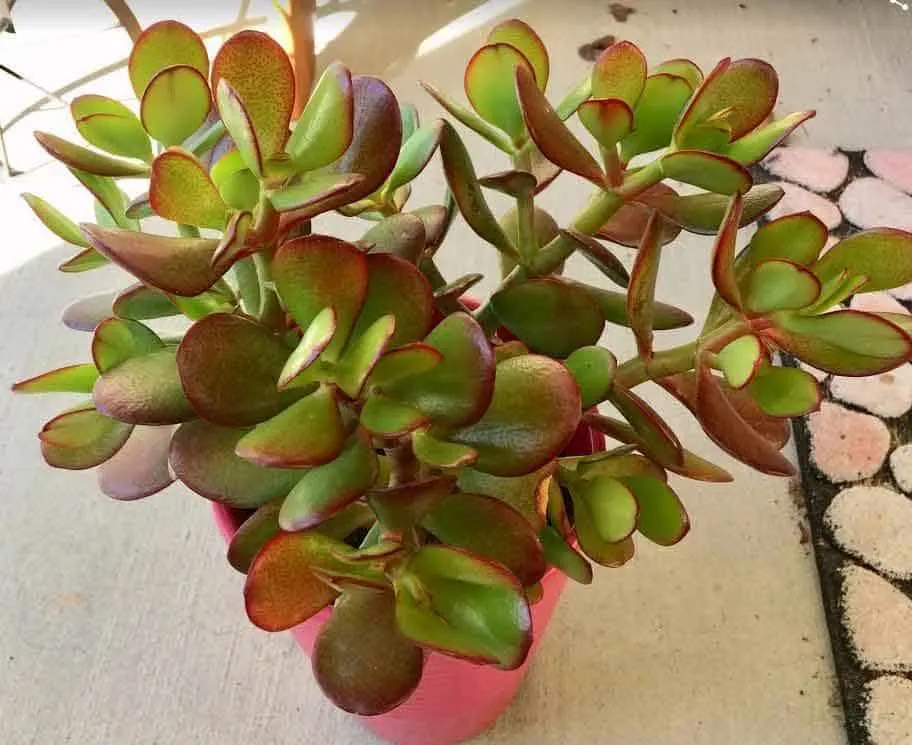
One with reddish tips on the leaves is in partial shade.
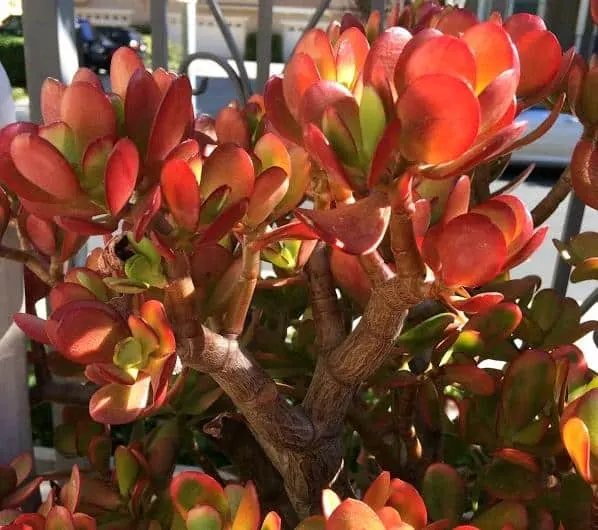
The third one with red leaves is in full sun, minimal watering and less rich soil.
All three are healthy and growing happily.
Sedum nussbaumerianum ‘Coppertone Stonecrop’
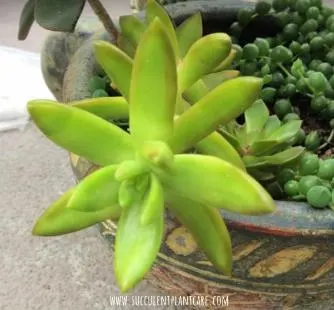
The one with green leaves is in a shaded area and fresh potting mix.
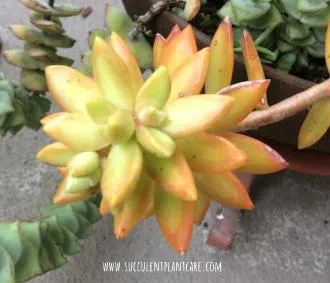
The one with yellow-orange leaves receives full sun and poor soil.
Aeonium arboreum ‘Zwartkop’ (Black Rose)
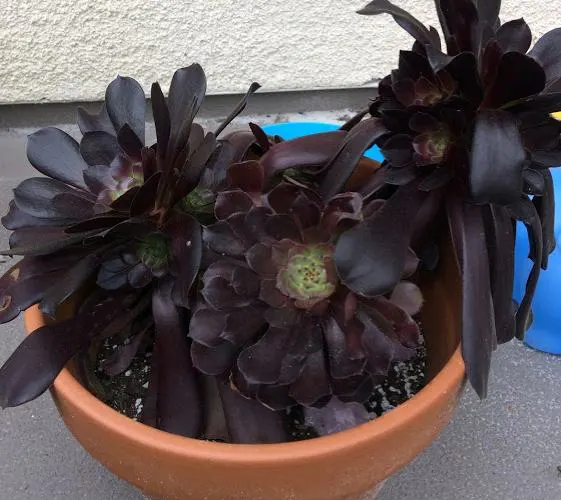
The first photo shows deep purple leaves.
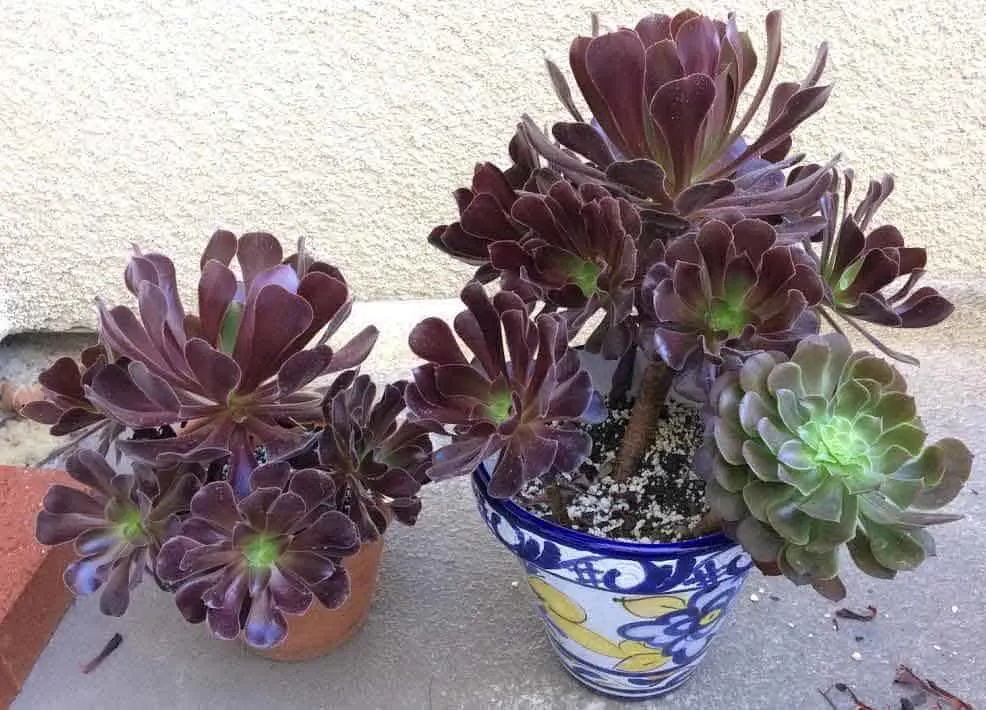
The second photo shows leaves get lighter and greener the more water and shade it receives.
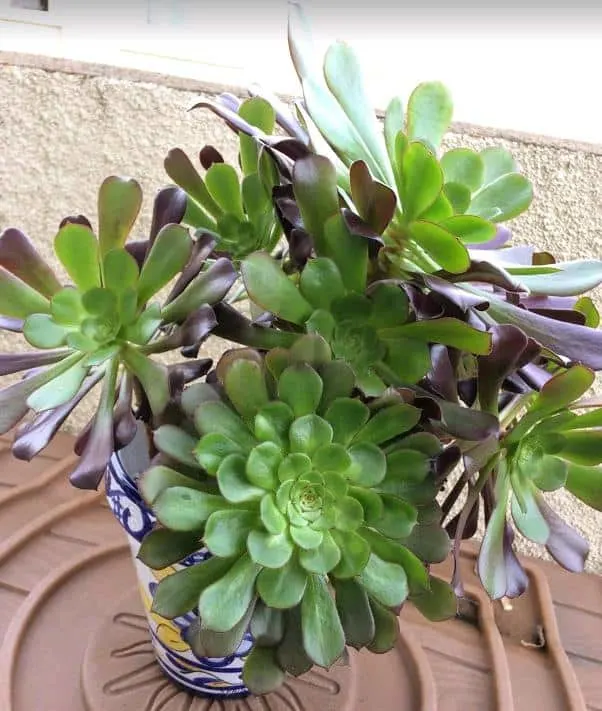
The last one was taken after a very rainy winter season. The plant has turned more green and has lost its darker purplish pigmentation.
All plants are healthy and happy, stressed or not.
Do All Succulents Turn Red or Change Colors Under Stress?
No. Some plants will naturally stay green no matter what they are exposed to. It all depends on the natural pigmentation they contain. This Portulacaria Afra ‘Elephant Bush’ stays green all year long outdoors, rain or shine. The shade of green may vary slightly depending on the weather, but it pretty much stays the same. If the leaves turn brown or yellow, I know it is a sign that something else is wrong with the plant. These Crassula Tetragona ‘Miniature Pine Trees’ are the same way. They pretty much stay green all year round. If I notice the leaves turning a different color like brown or yellow, then I know something is wrong with the plant.
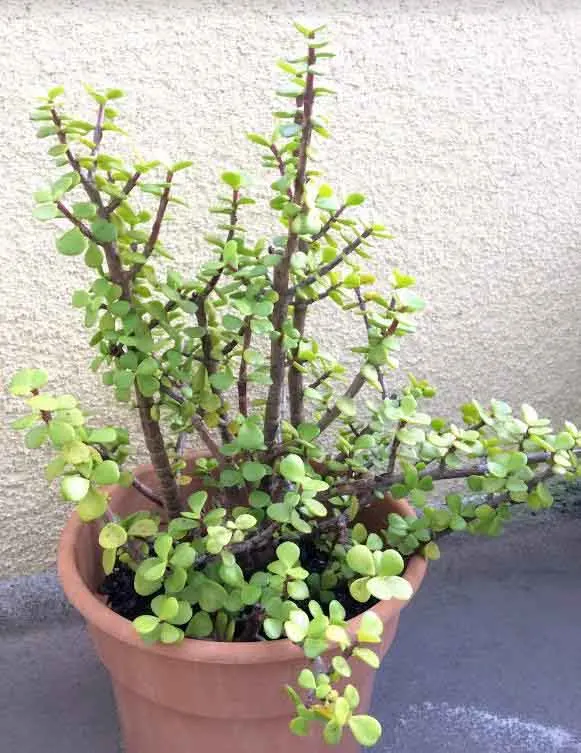
Portulacaria afra ‘Elephant Bush’ stays green all year round
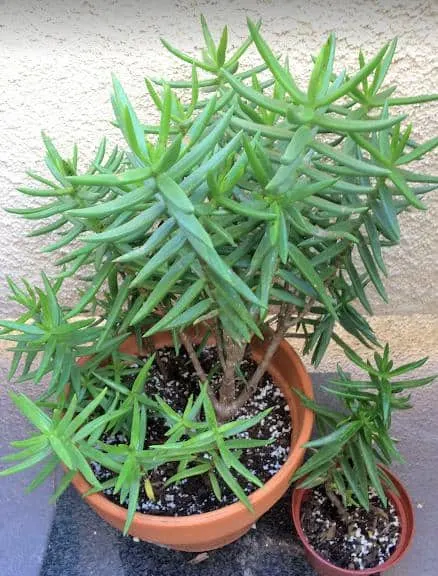
Crassula tetragona ‘Miniature Pine Trees’ stays green all year round
Why Would You Want To Stress Your Plant?
You may be thinking that you love your plants too much to stress them out. Succulents that are ‘pampered or babied’ too much may not reach their full potential (just like with us humans). A little bit of stress can be good for the plant. In their native habitat, succulents are faced with constant stressors in their environments and they are designed to cope with these changes rapidly to survive. These plants have become survivors because of all the stress they encounter in their native habitats. So don’t feel bad about stressing your succulents because they are tougher than you think.
To Stress Or Not To Stress?
Are you deciding whether or not to stress your succulents on purpose? It really is a personal choice and there is no right or wrong answer. I keep all of my succulents outdoors all year long, rain or shine and because of this, they are exposed to the natural elements outdoors without me having to manipulate their surroundings. My plants go through periods of stress all the time, some are good stress, some are not. And these are all inevitable when we deal with nature. Some things are just beyond our control no matter how much we try. Having a healthy plant is the main goal, the rest is icing on the cake if you ask me.
How To Bring Out The Best Colors in Succulents:
In order to bring out the best colors out of your succulents, keep these growing tips in mind.
Make sure the plants are in a suitable potting mix
Succulents do not need a rich soil. That’s because in their native habitats they grow in poor soil and harsh growing conditions. Provide a suitable well draining potting mix. I like to use cactus potting mix combined with perlite (2:1 solution).
If you live in a very humid location you can use 1:1 solution of cactus mix and perlite. I like this combination because it is easy, the materials are easy to find, and it works. For added drainage you can also add coarse sand to the mix (½ cactus mix, ¼ perlite, ¼ coarse sand or 1:1:1 solution for humid locations). Looking to purchase these materials? Check out my resource page for my recommendations on soil and soil amendments.
Go easy on the fertilizer
Succulents are not heavy feeders and do not need a lot of fertilizers. It is best to feed them during the active growing season. Apply fertilizers at a quarter or half strength of the recommended dosage on the package. Refrain from feeding during dormancy or when growth slows down, usually around mid-fall to winter, with a few exceptions.
Fertilizers can bring out the green color from the plants. Feed them less, you will see more vibrant colors come out of your plants. Looking to purchase succulent fertilizers? Check out my resource page for fertilizer recommendations.
To read more about the best soil and fertilizer for succulents, I have written an entire post here “Best Soil and Fertilizer For Succulents and Cacti”.
Water only when dry
Avoid sticking to a watering schedule. Instead, check the top inch of your soil to see if it is dry before you water. In my area where it is really dry, I water once every 7-10 days during the hot summer months. I decrease watering to every 10-14 days during the cooler months.
I refrain from watering my plants altogether during the winter months when we get a lot of rain in my area. You do not need to water as much if you live in a humid area or you keep your plants indoors. To read more about watering techniques for succulents, click on my post “How and When to Water Succulents”. Check out my resource page for helpful tools such as moisture meters to help you tell when to water your succulents.
Provide more sunlight
To bring out the best color in your succulent, increase the amount of light it receives. Generally speaking, succulents need about 5-6 hours of sunlight a day to thrive. Before exposing to more sun, make sure to do so gradually in order to avoid burning the plant. Increase sun exposure as tolerated.
Some plants will do better under full sun than others. Some plants, no matter how much you acclimate them to full sun, will still burn. Get to know your plants to know which ones will do well under full sun and which ones to keep in partial shade. Click on my post “How Much Sunlight Do Succulents Need?” for more information on this topic.
You can supplement your plant’s lighting needs with grow lights they do not get adequate sunlight. Here are my growlight recommendations.
Expose to heat or cold
Succulents exposed to the changing seasons including the summer heat and winter cold will display color changes throughout the season. Keep them outdoors as long as they can tolerate the heat or the cold without damaging them to see the amazing changes in color. Succulents kept indoors or in the shade will mostly stay green or revert back to green. Check out my post on “Optimal Temperatures for Succulents To Survive and Thrive” for more on this topic.
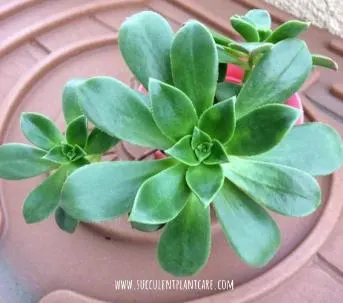
Aeonium Decorum ‘Green Pinwheel’
A little stress will bring out the reddish tips on the leaves of the plant.
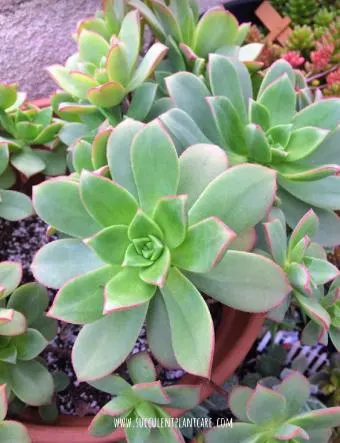
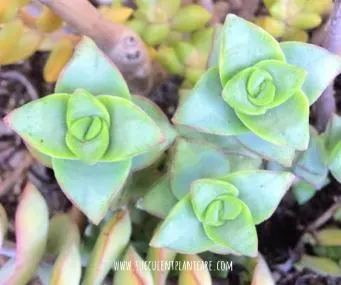
Crassula Perforata ‘String of Buttons’
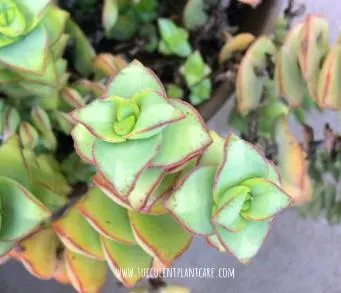
Stress the plant a little and you see the edges of the leaves turn a rosy-pink, purplish color.

Graptopetallum ‘Copper Rose’

Stress brings out the mauve-pink, coppery color in the plant.
Stress is not necessarily a bad thing. A stressed out plant can still be a happy plant. Sometimes, the most beautiful colors in succulents come only when the plant is going through periods of harmless stress. It’s amazing to see the range of color changes one succulent plant can go through even with just a slight change in the environment.
These color changes really showcase the beauty of these plants and help explain why they are such popular and extraordinary plants.
If you have trouble distinguishing between good stress and bad stress, you may find this post useful where I describe in details what to do with a troubled succulent plant: “Why Are My Succulents Turning Brown, Yellow or Black?”
Check out my Resource Page for recommendations on where to purchase succulents online.
Pin this to save for later or share with others now!
